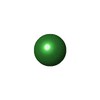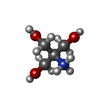[English] 日本語
 Yorodumi
Yorodumi- PDB-2pr0: Crystal structure of Sylvaticin, a new secreted protein from Pyth... -
+ Open data
Open data
- Basic information
Basic information
| Entry | Database: PDB / ID: 2pr0 | ||||||
|---|---|---|---|---|---|---|---|
| Title | Crystal structure of Sylvaticin, a new secreted protein from Pythium Sylvaticum | ||||||
 Components Components | sylvaticin | ||||||
 Keywords Keywords | TOXIN / elicitin | ||||||
| Function / homology |  Function and homology information Function and homology informationsymbiont-mediated perturbation of host programmed cell death / extracellular region Similarity search - Function | ||||||
| Biological species |  Pythium sylvaticum (eukaryote) Pythium sylvaticum (eukaryote) | ||||||
| Method |  X-RAY DIFFRACTION / X-RAY DIFFRACTION /  SYNCHROTRON / SYNCHROTRON /  SAD / Resolution: 1.72 Å SAD / Resolution: 1.72 Å | ||||||
 Authors Authors | Lascombe, M.B. / Prange, T. / Retailleau, P. | ||||||
 Citation Citation |  Journal: Acta Crystallogr.,Sect.D / Year: 2007 Journal: Acta Crystallogr.,Sect.D / Year: 2007Title: Structure of sylvaticin, a new alpha-elicitin-like protein from Pythium sylvaticum. Authors: Lascombe, M.B. / Retailleau, P. / Ponchet, M. / Industri, B. / Blein, J.P. / Prange, T. #1:  Journal: Acta Crystallogr.,Sect.D / Year: 2004 Journal: Acta Crystallogr.,Sect.D / Year: 2004Title: Purification, crystallization and preliminary X-ray studies of sylvaticin, an elicitin-like protein from Pythium sylvaticum Authors: Lascombe, M.-B. / Ponchet, M. / Cardin, L. / Milat, M.-L. / Blein, J.-P. / Prange, T. | ||||||
| History |
| ||||||
| Remark 999 | sequence The sequence of this protein is not available in the UNP database at the time of processing |
- Structure visualization
Structure visualization
| Structure viewer | Molecule:  Molmil Molmil Jmol/JSmol Jmol/JSmol |
|---|
- Downloads & links
Downloads & links
- Download
Download
| PDBx/mmCIF format |  2pr0.cif.gz 2pr0.cif.gz | 54.9 KB | Display |  PDBx/mmCIF format PDBx/mmCIF format |
|---|---|---|---|---|
| PDB format |  pdb2pr0.ent.gz pdb2pr0.ent.gz | 38.5 KB | Display |  PDB format PDB format |
| PDBx/mmJSON format |  2pr0.json.gz 2pr0.json.gz | Tree view |  PDBx/mmJSON format PDBx/mmJSON format | |
| Others |  Other downloads Other downloads |
-Validation report
| Summary document |  2pr0_validation.pdf.gz 2pr0_validation.pdf.gz | 449.6 KB | Display |  wwPDB validaton report wwPDB validaton report |
|---|---|---|---|---|
| Full document |  2pr0_full_validation.pdf.gz 2pr0_full_validation.pdf.gz | 452.7 KB | Display | |
| Data in XML |  2pr0_validation.xml.gz 2pr0_validation.xml.gz | 14.7 KB | Display | |
| Data in CIF |  2pr0_validation.cif.gz 2pr0_validation.cif.gz | 19.3 KB | Display | |
| Arichive directory |  https://data.pdbj.org/pub/pdb/validation_reports/pr/2pr0 https://data.pdbj.org/pub/pdb/validation_reports/pr/2pr0 ftp://data.pdbj.org/pub/pdb/validation_reports/pr/2pr0 ftp://data.pdbj.org/pub/pdb/validation_reports/pr/2pr0 | HTTPS FTP |
-Related structure data
- Links
Links
- Assembly
Assembly
| Deposited unit | 
| ||||||||
|---|---|---|---|---|---|---|---|---|---|
| 1 | 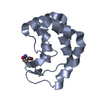
| ||||||||
| 2 | 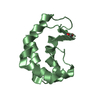
| ||||||||
| Unit cell |
|
- Components
Components
| #1: Protein | Mass: 10411.029 Da / Num. of mol.: 2 / Source method: isolated from a natural source / Source: (natural)  Pythium sylvaticum (eukaryote) / Strain: strain 37 / References: UniProt: D0VWX7*PLUS Pythium sylvaticum (eukaryote) / Strain: strain 37 / References: UniProt: D0VWX7*PLUS#2: Chemical | #3: Chemical | #4: Water | ChemComp-HOH / | Has protein modification | Y | |
|---|
-Experimental details
-Experiment
| Experiment | Method:  X-RAY DIFFRACTION / Number of used crystals: 1 X-RAY DIFFRACTION / Number of used crystals: 1 |
|---|
- Sample preparation
Sample preparation
| Crystal | Density Matthews: 2.11 Å3/Da / Density % sol: 41.82 % |
|---|---|
| Crystal grow | Temperature: 298 K / Method: vapor diffusion, hanging drop / pH: 7.5 Details: 20% PEG 2000 MME, 0.01M NiCl2, 0.1M Tris-HKL pH 7.5, VAPOR DIFFUSION, HANGING DROP, temperature 298K |
-Data collection
| Diffraction | Mean temperature: 100 K | |||||||||
|---|---|---|---|---|---|---|---|---|---|---|
| Diffraction source | Source:  SYNCHROTRON / Site: SYNCHROTRON / Site:  ESRF ESRF  / Beamline: BM14 / Wavelength: 1.480, 1.239 / Beamline: BM14 / Wavelength: 1.480, 1.239 | |||||||||
| Detector | Type: MARMOSAIC 225 mm CCD / Detector: CCD / Date: Sep 14, 2003 / Details: mirrors | |||||||||
| Radiation | Monochromator: Si(111) monochromator / Protocol: SINGLE WAVELENGTH / Monochromatic (M) / Laue (L): M / Scattering type: x-ray | |||||||||
| Radiation wavelength |
| |||||||||
| Reflection | Resolution: 1.72→26 Å / Num. obs: 18321 / % possible obs: 92.9 % / Observed criterion σ(F): 1 / Observed criterion σ(I): 1 / Rmerge(I) obs: 0.048 / Net I/σ(I): 24.2 | |||||||||
| Reflection shell | Resolution: 1.72→1.82 Å / Rmerge(I) obs: 0.073 / Mean I/σ(I) obs: 12.5 / % possible all: 71.8 |
- Processing
Processing
| Software |
| ||||||||||||||||||||||||||||
|---|---|---|---|---|---|---|---|---|---|---|---|---|---|---|---|---|---|---|---|---|---|---|---|---|---|---|---|---|---|
| Refinement | Method to determine structure:  SAD / Resolution: 1.72→25.9 Å / Isotropic thermal model: Isotropic / Cross valid method: THROUGHOUT / σ(F): 1 / σ(I): 1 / Stereochemistry target values: Engh & Huber SAD / Resolution: 1.72→25.9 Å / Isotropic thermal model: Isotropic / Cross valid method: THROUGHOUT / σ(F): 1 / σ(I): 1 / Stereochemistry target values: Engh & Huber
| ||||||||||||||||||||||||||||
| Displacement parameters | Biso mean: 19.444 Å2 | ||||||||||||||||||||||||||||
| Refine analyze | Luzzati coordinate error obs: 0.18 Å / Luzzati sigma a obs: 0.11 Å | ||||||||||||||||||||||||||||
| Refinement step | Cycle: LAST / Resolution: 1.72→25.9 Å
| ||||||||||||||||||||||||||||
| Refine LS restraints |
| ||||||||||||||||||||||||||||
| LS refinement shell | Resolution: 1.72→1.78 Å
|
 Movie
Movie Controller
Controller


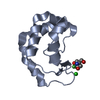
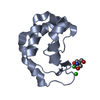
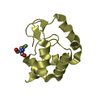

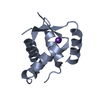
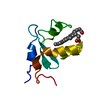
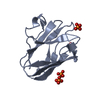
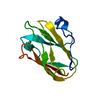
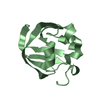
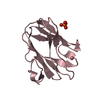
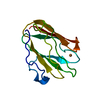
 PDBj
PDBj